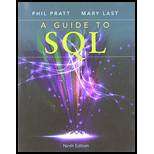
A Guide to SQL
9th Edition
ISBN: 9781111527273
Author: Philip J. Pratt
Publisher: Course Technology Ptr
expand_more
expand_more
format_list_bulleted
Expert Solution & Answer
Chapter 3, Problem 12RQ
Explanation of Solution
Difference between “CHAR” and “VARCHAR”:
| CHAR | VARCHAR |
| “CHAR” is fixed length data type. | “VARCHAR” is the variable length data type. |
| The storage size is equal to the maximum size of the column. | The storage size is equal to the actual length of the data. |
| The keyword “CHAR” is used to declare the variable... |
Explanation of Solution
Appropriate place to use “CHAR” data type:
The “CHAR” data type is a good choice when storing the initial of the name as it takes up the same amount of bytes. It is also suitable to specify the name of the individual as it hold only the list of characters.
Example:
CREATE TABLE EMPLOYEE (
EMP_NU...
Explanation of Solution
URL:
The following given URL provides the examples as referen...
Expert Solution & Answer
Want to see the full answer?
Check out a sample textbook solution
Students have asked these similar questions
We are considering the RSA encryption scheme. The involved numbers are small, so the communication is insecure. Alice's public key (n,public_key) is (247,7).
A code breaker manages to factories 247 = 13 x 19
Determine Alice's secret key.
To solve the problem, you need not use the extended Euclid algorithm, but you may assume that her private key is one of the following numbers 31,35,55,59,77,89.
Consider the following Turing Machine (TM). Does the TM halt if it begins on the empty tape? If it halts, after how many steps? Does the TM halt if it begins on a tape that contains a single letter A followed by blanks? Justify your answer.
Pllleasassseee ssiiirrrr soolveee thissssss questionnnnnnn
Chapter 3 Solutions
A Guide to SQL
Ch. 3 - Prob. 1RQCh. 3 - How do you delete a table using SQL?Ch. 3 - Prob. 3RQCh. 3 - Prob. 4RQCh. 3 - Prob. 5RQCh. 3 - Prob. 6RQCh. 3 - Prob. 7RQCh. 3 - Prob. 8RQCh. 3 - Prob. 9RQCh. 3 - Prob. 10RQ
Ch. 3 - Prob. 11RQCh. 3 - Prob. 12RQCh. 3 - Prob. 13RQCh. 3 - Use SQL to complete the following exercises....Ch. 3 - Prob. 2TDCh. 3 - Prob. 3TDCh. 3 - Prob. 4TDCh. 3 - Prob. 5TDCh. 3 - Prob. 6TDCh. 3 - Prob. 7TDCh. 3 - Prob. 1CATCh. 3 - Add the following row to the ADVENTURE_TRIP table:...Ch. 3 - Prob. 3CATCh. 3 - Prob. 4CATCh. 3 - Prob. 5CATCh. 3 - Prob. 6CATCh. 3 - Review the data for the TRIP table in Figure 1-5...Ch. 3 - Colonial Adventure Tours would like to increase...Ch. 3 - Prob. 1SCGCh. 3 - Add the following record to the VACATION_UNIT...Ch. 3 - Delete the VACATION_UNIT table.Ch. 3 - Prob. 4SCGCh. 3 - Prob. 5SCGCh. 3 - Prob. 6SCGCh. 3 - The SERVICE_REQUEST table uses the CHAR data type...
Knowledge Booster
Similar questions
- 4. def modify_data(x, my_list): X = X + 1 my_list.append(x) print(f"Inside the function: x = {x}, my_list = {my_list}") num = 5 numbers = [1, 2, 3] modify_data(num, numbers) print(f"Outside the function: num = {num}, my_list = {numbers}") Classe Classe that lin Thus, A pro is ref inter Ever dict The The output: Inside the function:? Outside the function:?arrow_forwardpython Tasks 5 • Task 1: Building a Library Management system. Write a Book class and a function to filter books by publication year. • Task 2: Create a Person class with name and age attributes, and calculate the average age of a list of people Task 3: Building a Movie Collection system. Each movie has a title, a genre, and a rating. Write a function to filter movies based on a minimum rating. ⚫ Task 4: Find Young Animals. Create an Animal class with name, species, and age attributes, and track the animals' ages to know which ones are still young. • Task 5(homework): In a store's inventory system, you want to apply discounts to products and filter those with prices above a specified amount. 27/04/1446arrow_forwardOf the five primary components of an information system (hardware, software, data, people, process), which do you think is the most important to the success of a business organization? Part A - Define each primary component of the information system. Part B - Include your perspective on why your selection is most important. Part C - Provide an example from your personal experience to support your answer.arrow_forward
- Management Information Systemsarrow_forwardQ2/find the transfer function C/R for the system shown in the figure Re དarrow_forwardPlease original work select a topic related to architectures or infrastructures (Data Lakehouse Architecture). Discussing how you would implement your chosen topic in a data warehouse project Please cite in text references and add weblinksarrow_forward
- Please original work What topic would be related to architectures or infrastructures. How you would implement your chosen topic in a data warehouse project. Please cite in text references and add weblinksarrow_forwardWhat is cloud computing and why do we use it? Give one of your friends with your answer.arrow_forwardWhat are triggers and how do you invoke them on demand? Give one reference with your answer.arrow_forward
arrow_back_ios
SEE MORE QUESTIONS
arrow_forward_ios
Recommended textbooks for you
 A Guide to SQLComputer ScienceISBN:9781111527273Author:Philip J. PrattPublisher:Course Technology PtrNp Ms Office 365/Excel 2016 I NtermedComputer ScienceISBN:9781337508841Author:CareyPublisher:Cengage
A Guide to SQLComputer ScienceISBN:9781111527273Author:Philip J. PrattPublisher:Course Technology PtrNp Ms Office 365/Excel 2016 I NtermedComputer ScienceISBN:9781337508841Author:CareyPublisher:Cengage
- COMPREHENSIVE MICROSOFT OFFICE 365 EXCEComputer ScienceISBN:9780357392676Author:FREUND, StevenPublisher:CENGAGE L

A Guide to SQL
Computer Science
ISBN:9781111527273
Author:Philip J. Pratt
Publisher:Course Technology Ptr

Np Ms Office 365/Excel 2016 I Ntermed
Computer Science
ISBN:9781337508841
Author:Carey
Publisher:Cengage


COMPREHENSIVE MICROSOFT OFFICE 365 EXCE
Computer Science
ISBN:9780357392676
Author:FREUND, Steven
Publisher:CENGAGE L